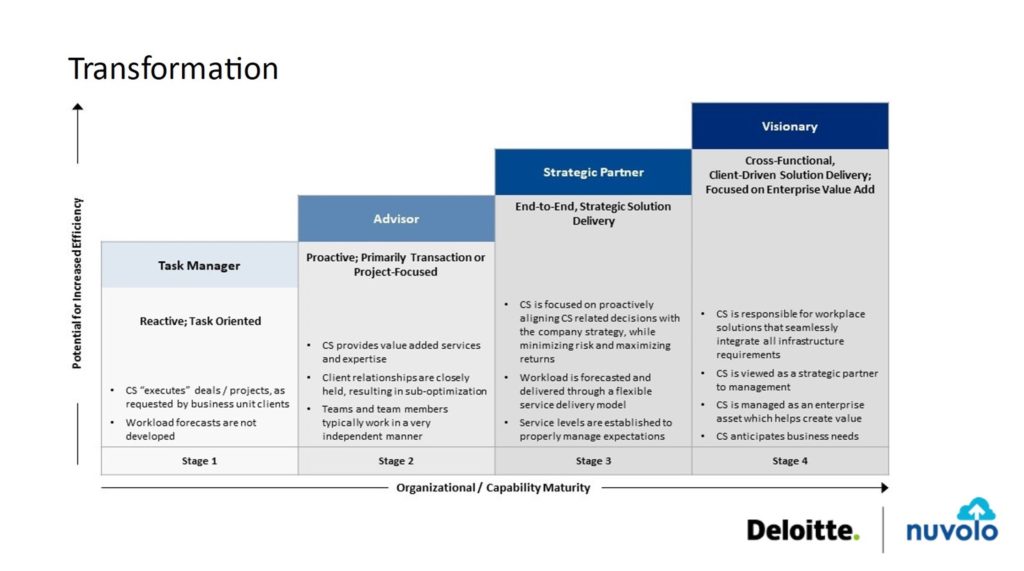Facilities management is often complex and involves lots of moving pieces. Whether it’s monitoring inventory, fulfilling maintenance requests, or making inspection rounds, your team is likely completing a mountain of tasks every single day.
This busy environment can create a silo effect where facilities teams work in their own bubble and simply react to the needs of the moment. Over time, they develop a “reactive” system for handling their work. One of your business units makes a request, and the facilities team responds to it. Rinse and repeat.
But what if your facilities team had the potential to do much more? What if they were part of an interconnected workplace system that allowed them to predict workloads and support key business objectives across your organization?
Using tools like Nuvolo Connected Workplace, many organizations are already making this a reality. With the right digital solution in place, they’re able to develop mature, fully connected facilities operations teams that proactively seek business solutions and function as strategic partners to management.
In this post, we’ll take a look at the four levels of facilities management maturity and explore three ways you can take your team from reactive to visionary.
The 4 Levels of Facilities Operations Maturity
We can group facilities operations teams into four categories based on their “maturity,” or ability to function as an enterprise asset. As a team progresses along the scale, it increases its capacity to deliver efficiency, predictability, and strategic value to the organization.

- Task manager: Teams at this level are primarily reactive, focused on receiving requests and executing day-to-day tasks. They lack the insights to predict workloads and the tools to automate common processes. In addition, they likely have very little visibility into other areas of the organization.
- Advisor: A team at the Advisor level is more proactive, offering value-added services and expertise to the organization. The team works closely with other business units to execute projects, although it still functions mostly independently with limited (if any) cross-departmental goal alignment. Workload predictability is still not available at this level.
- Strategic partner: At this level, a facilities team is actively aligned with company strategy. Their workload is forecasted, and they’re able to manage and adjust expectations through a flexible service delivery model. With a moderate amount of visibility into other business units, these teams leverage company-wide insights to reduce risk and ensure maximum return for their efforts.
- Visionary: A fully mature facilities operations team functions at the Visionary level—which means they proactively anticipate business needs and work in lockstep with company strategy. Using extensive data and seamless cross-departmental collaboration, these teams not only execute company strategy—they help shape it, too. The team is regarded as a strategic partner to management and helps deliver maximum value across the company at every turn.
3 Ways to Create a Visionary Facilities Operations Team
Facilities operations teams at the Visionary level are efficient, proactive, and fully connected to business units across the organization. That makes them an indispensable part of the company.
But this kind of performance doesn’t happen overnight. It takes a concentrated effort to get there.
So, how do companies with Visionary facilities teams do it? They start with three important steps: specializing, standardizing, and visualizing—all made simple through Connected Workplace.
Let’s take a look at how these work.
1. Specialize: Embrace more outsourcing
Engaging vendors that know the business of facilities management can be a major value-add for your company. Their specialized knowledge and complete dedication to this key business function can help you save costs, gain predictability, and reclaim time for your own employees.
It’s worth noting that many companies avoid this option because it’s too cumbersome, time-consuming, or both. But with Connected Workplace, you can manage vendor relationships—no spreadsheets or clumsy processes involved. Your vendors even get access to a self-service portal where they can complete work orders, submit invoices, and track performance.
2. Standardize: Create facility services standards
You wouldn’t want to assemble a piece of furniture without instructions—so why would you let your facilities team operate without standard procedures in place? Customizing processes from scratch every time is difficult, costly, and time-consuming, not to mention frustrating for all parties involved.
Creating and cataloging facility services standards gives your technicians and other service providers a reliable set of resources to support your business operations. Using Connected Workplace, you can build and store these standards in one platform, allowing universal access for everyone on your facilities operations team. You can also track vendor performance against these standards using robust reporting and analytics tools that track data for all assets and work orders.
3. Visualize: Make sure you’re capturing key data
When it comes to facilities management data, your team needs to be able to rely on one single source of truth. Working from different databases or programs can lead to inefficiencies, errors, and duplicated efforts. If your facilities team isn’t conducting operations using a unified source of information in real-time, this part of your company is falling behind.
Fortunately, Connected Workplace makes this easy. It captures all your facilities operations data in the cloud in real-time, delivering near instantaneous updates to every connected team member. Your data remains consistent and accessible across countries, regions, and sites. It brings you business intelligence that saves your company significant time and money.
The Bottom Line
Building a Visionary facilities operations team takes time, but implementing a cloud-based solution like Connected Workplace can help you get there and stay there. By creating a specialized facilities workforce, standardizing your team’s services, and implementing robust data capabilities, you can take your team from Reactive to Visionary and sustain much higher levels of performance over time.
Want to know more? Watch this webinar to see how Chevron transformed their global facilities maintenance operations using Connected Workplace.